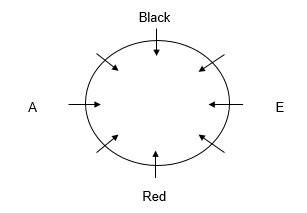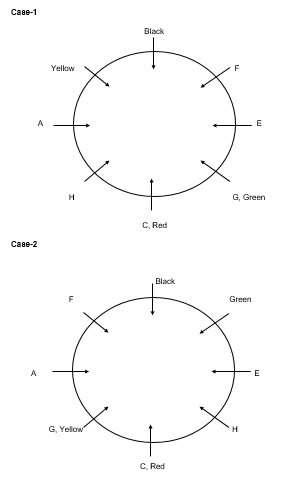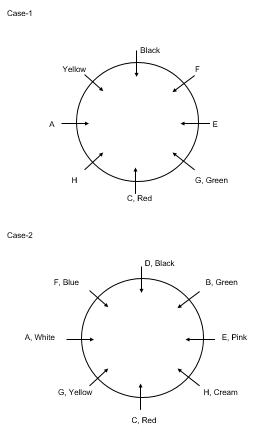Question
Who sits in front of
F? Answer the questions based on the information given below. Eight persons A, B, C, D, E, F, G and H are sitting around a circular table facing inside but not necessarily in the same order. All of them likes different colour viz. Red, Green, Yellow, Blue, White, Black, Pink and Cream but not necessary in same order. Only one person sits between E and the one who likes Red. A sits second to the left of the one who likes Red. H is an immediate neighbour of C. C is not an immediate neighbour of A or E and he does not likes Black. E sits second to the left of the one who likes Black. Only three people sit between the one who likes Green and the one who likes Yellow. F sits second to the left of the one who likes Yellow. H does not likes Blue. The one who likes Blue is not an immediate neighbor of H. D sits on the immediate left of the one who likes Blue. The one who likes Pink sits on the immediate right of the one who likes Cream. Only two persons sit between G and the one who has likes Black. The one who likes Green sits second to the right of H.Solution
Only one person sits between E and the one who likes Red. A sits second to the left of the one who likes Red. If the one who likes Red sits at place no.1, then A sits at place no. 7 and E sits at place no. 3. E sits second to the left of the one who likes Black. So, the one who likes Black at place no. 5.  Only two persons sit between G and the one who has likes Black. From this statement, we will have two cases: G will sit either at place no. 2 or 8. H is an immediate neighbour of C. C is not an immediate neighbour of A or E and he does not like Black. The one who likes Green sits second to the right of H. C cannot sit at places no. 6, 5, 4, and 8. So, the only place left for him is place no. 1. As H is an immediate neighbour of C. So, H will sit either at place no. 8 or 2. The one who likes Green sits either at place no. 4 or 2. Only three people sit between the one who likes Green and the one who likes Yellow. So, the one who likes Yellow sits either at place no. 6 or 8. F sits second to the left of the one who likes Yellow. So, F sits either at place no. 4 or 6.
Only two persons sit between G and the one who has likes Black. From this statement, we will have two cases: G will sit either at place no. 2 or 8. H is an immediate neighbour of C. C is not an immediate neighbour of A or E and he does not like Black. The one who likes Green sits second to the right of H. C cannot sit at places no. 6, 5, 4, and 8. So, the only place left for him is place no. 1. As H is an immediate neighbour of C. So, H will sit either at place no. 8 or 2. The one who likes Green sits either at place no. 4 or 2. Only three people sit between the one who likes Green and the one who likes Yellow. So, the one who likes Yellow sits either at place no. 6 or 8. F sits second to the left of the one who likes Yellow. So, F sits either at place no. 4 or 6.  H does not likes Blue. The one who likes Blue is not an immediate neighbor of H. D sits on the immediate left of the one who likes Blue. The one who likes Pink sits on the immediate right of the one who likes Cream. Case 1 will get discarded as the one who likes Blue cannot sit at place no. 7 and 8. If the one who likes Blue sits either at place no. 4 or 3, then there is no place for D as D sits on the immediate left of the one who likes Blue In case 2, if the one who likes Blue sits at place no. 6, then D sits at place no. 5. The one who likes Pink and the one who likes Cream sit at place no. 3 and 2 respectively Only person left for place no. 4 is B. Only colour left for A is White.
H does not likes Blue. The one who likes Blue is not an immediate neighbor of H. D sits on the immediate left of the one who likes Blue. The one who likes Pink sits on the immediate right of the one who likes Cream. Case 1 will get discarded as the one who likes Blue cannot sit at place no. 7 and 8. If the one who likes Blue sits either at place no. 4 or 3, then there is no place for D as D sits on the immediate left of the one who likes Blue In case 2, if the one who likes Blue sits at place no. 6, then D sits at place no. 5. The one who likes Pink and the one who likes Cream sit at place no. 3 and 2 respectively Only person left for place no. 4 is B. Only colour left for A is White.  Case - 2 is the final arrangement.
Case - 2 is the final arrangement.
A disease of citrus plants in which cracks develop in the bark and sap oozes out. Profuse gumming on the surface is seen. It also causes leaf rot.
Cattle semen is frozen and stored for long periods in liquid nitrogen at temperature:
How many Soil health card has been distributed?
Chronology in the grass-weed growth stages is
A. Booting
B. Tillering
C. Anthesis
D. Dough
E. Seedling
Choose ...
Detasseling is done in maize to ______
Which of the following is/are the National referral laboratory/(ies) nominated and funded by APEDA?
Which of the following is popularly known as queen of vegetables?
Gibberellins was discovered by the Japanese scientist ........... in the year 1926.
_________is the first organ to emerge from the seed.
Sea tides show variations because of:


